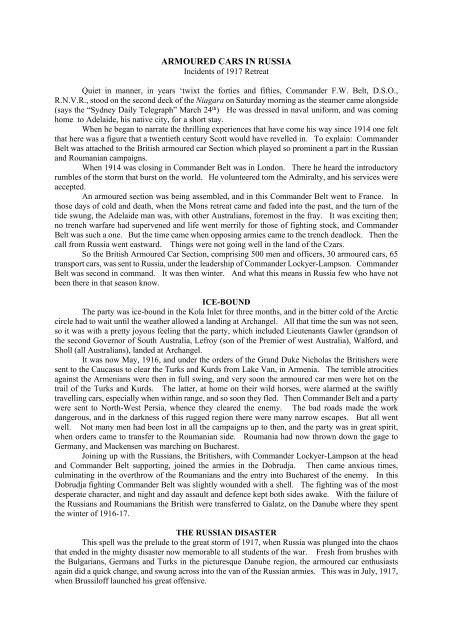World War I Roll of Honour - The Clove Club Hackney Downs School
World War I Roll of Honour - The Clove Club Hackney Downs School
World War I Roll of Honour - The Clove Club Hackney Downs School
Create successful ePaper yourself
Turn your PDF publications into a flip-book with our unique Google optimized e-Paper software.
ARMOURED CARS IN RUSSIA<br />
Incidents <strong>of</strong> 1917 Retreat<br />
Quiet in manner, in years ‘twixt the forties and fifties, Commander F.W. Belt, D.S.O.,<br />
R.N.V.R., stood on the second deck <strong>of</strong> the Niagara on Saturday morning as the steamer came alongside<br />
(says the “Sydney Daily Telegraph” March 24 th ) He was dressed in naval uniform, and was coming<br />
home to Adelaide, his native city, for a short stay.<br />
When he began to narrate the thrilling experiences that have come his way since 1914 one felt<br />
that here was a figure that a twentieth century Scott would have revelled in. To explain: Commander<br />
Belt was attached to the British armoured car Section which played so prominent a part in the Russian<br />
and Roumanian campaigns.<br />
When 1914 was closing in Commander Belt was in London. <strong>The</strong>re he heard the introductory<br />
rumbles <strong>of</strong> the storm that burst on the world. He volunteered tom the Admiralty, and his services were<br />
accepted.<br />
An armoured section was being assembled, and in this Commander Belt went to France. In<br />
those days <strong>of</strong> cold and death, when the Mons retreat came and faded into the past, and the turn <strong>of</strong> the<br />
tide swung, the Adelaide man was, with other Australians, foremost in the fray. It was exciting then;<br />
no trench warfare had supervened and life went merrily for those <strong>of</strong> fighting stock, and Commander<br />
Belt was such a one. But the time came when opposing armies came to the trench deadlock. <strong>The</strong>n the<br />
call from Russia went eastward. Things were not going well in the land <strong>of</strong> the Czars.<br />
So the British Armoured Car Section, comprising 500 men and <strong>of</strong>ficers, 30 armoured cars, 65<br />
transport cars, was sent to Russia, under the leadership <strong>of</strong> Commander Lockyer-Lampson. Commander<br />
Belt was second in command. It was then winter. And what this means in Russia few who have not<br />
been there in that season know.<br />
ICE-BOUND<br />
<strong>The</strong> party was ice-bound in the Kola Inlet for three months, and in the bitter cold <strong>of</strong> the Arctic<br />
circle had to wait until the weather allowed a landing at Archangel. All that time the sun was not seen,<br />
so it was with a pretty joyous feeling that the party, which included Lieutenants Gawler (grandson <strong>of</strong><br />
the second Governor <strong>of</strong> South Australia, Lefroy (son <strong>of</strong> the Premier <strong>of</strong> west Australia), Walford, and<br />
Sholl (all Australians), landed at Archangel.<br />
It was now May, 1916, and under the orders <strong>of</strong> the Grand Duke Nicholas the Britishers were<br />
sent to the Caucasus to clear the Turks and Kurds from Lake Van, in Armenia. <strong>The</strong> terrible atrocities<br />
against the Armenians were then in full swing, and very soon the armoured car men were hot on the<br />
trail <strong>of</strong> the Turks and Kurds. <strong>The</strong> latter, at home on their wild horses, were alarmed at the swiftly<br />
travelling cars, especially when within range, and so soon they fled. <strong>The</strong>n Commander Belt and a party<br />
were sent to North-West Persia, whence they cleared the enemy. <strong>The</strong> bad roads made the work<br />
dangerous, and in the darkness <strong>of</strong> this rugged region there were many narrow escapes. But all went<br />
well. Not many men had been lost in all the campaigns up to then, and the party was in great spirit,<br />
when orders came to transfer to the Roumanian side. Roumania had now thrown down the gage to<br />
Germany, and Mackensen was marching on Bucharest.<br />
Joining up with the Russians, the Britishers, with Commander Lockyer-Lampson at the head<br />
and Commander Belt supporting, joined the armies in the Dobrudja. <strong>The</strong>n came anxious times,<br />
culminating in the overthrow <strong>of</strong> the Roumanians and the entry into Bucharest <strong>of</strong> the enemy. In this<br />
Dobrudja fighting Commander Belt was slightly wounded with a shell. <strong>The</strong> fighting was <strong>of</strong> the most<br />
desperate character, and night and day assault and defence kept both sides awake. With the failure <strong>of</strong><br />
the Russians and Roumanians the British were transferred to Galatz, on the Danube where they spent<br />
the winter <strong>of</strong> 1916-17.<br />
THE RUSSIAN DISASTER<br />
This spell was the prelude to the great storm <strong>of</strong> 1917, when Russia was plunged into the chaos<br />
that ended in the mighty disaster now memorable to all students <strong>of</strong> the war. Fresh from brushes with<br />
the Bulgarians, Germans and Turks in the picturesque Danube region, the armoured car enthusiasts<br />
again did a quick change, and swung across into the van <strong>of</strong> the Russian armies. This was in July, 1917,<br />
when Brussil<strong>of</strong>f launched his great <strong>of</strong>fensive.


